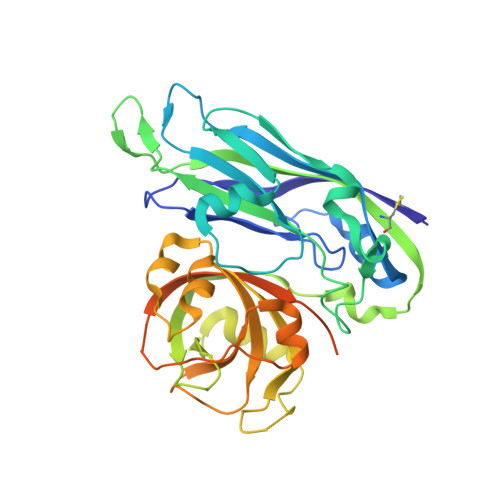Structural, Mechanistic, and Antigenic Characterization of the Human Astrovirus Capsid.
York, R.L., Yousefi, P.A., Bogdanoff, W., Haile, S., Tripathi, S., DuBois, R.M.(2015) J Virol 90: 2254-2263
- PubMed: 26656707
- DOI: https://doi.org/10.1128/JVI.02666-15
- Primary Citation of Related Structures:
5EWN, 5EWO - PubMed Abstract:
Human astroviruses (HAstVs) are nonenveloped, positive-sense, single-stranded RNA viruses that are a leading cause of viral gastroenteritis. HAstV particles display T=3 icosahedral symmetry formed by 180 copies of the capsid protein (CP), which undergoes proteolytic maturation to generate infectious HAstV particles. Little is known about the molecular features that govern HAstV particle assembly, maturation, infectivity, and immunogenicity. Here we report the crystal structures of the two main structural domains of the HAstV CP: the core domain at 2.60-Å resolution and the spike domain at 0.95-Å resolution. Fitting of these structures into the previously determined 25-Å-resolution electron cryomicroscopy density maps of HAstV allowed us to characterize the molecular features on the surfaces of immature and mature T=3 HAstV particles. The highly electropositive inner surface of HAstV supports a model in which interaction of the HAstV CP core with viral RNA is a driving force in T=3 HAstV particle formation. Additionally, mapping of conserved residues onto the HAstV CP core and spike domains in the context of the immature and mature HAstV particles revealed dramatic changes to the exposure of conserved residues during virus maturation. Indeed, we show that antibodies raised against mature HAstV have reactivity to both the HAstV CP core and spike domains, revealing for the first time that the CP core domain is antigenic. Together, these data provide new molecular insights into HAstV that have practical applications for the development of vaccines and antiviral therapies. Astroviruses are a leading cause of viral diarrhea in young children, immunocompromised individuals, and the elderly. Despite the prevalence of astroviruses, little is known at the molecular level about how the astrovirus particle assembles and is converted into an infectious, mature virus. In this paper, we describe the high-resolution structures of the two main astrovirus capsid proteins. Fitting these structures into previously determined low-resolution maps of astrovirus allowed us to characterize the molecular surfaces of immature and mature astroviruses. Our studies provide the first evidence that astroviruses undergo viral RNA-dependent assembly. We also provide new insight into the molecular mechanisms that lead to astrovirus maturation and infectivity. Finally, we show that both capsid proteins contribute to the adaptive immune response against astrovirus. Together, these studies will help to guide the development of vaccines and antiviral drugs targeting astrovirus.
Organizational Affiliation:
Department of Biomolecular Engineering, University of California Santa Cruz, Santa Cruz, California, USA.















